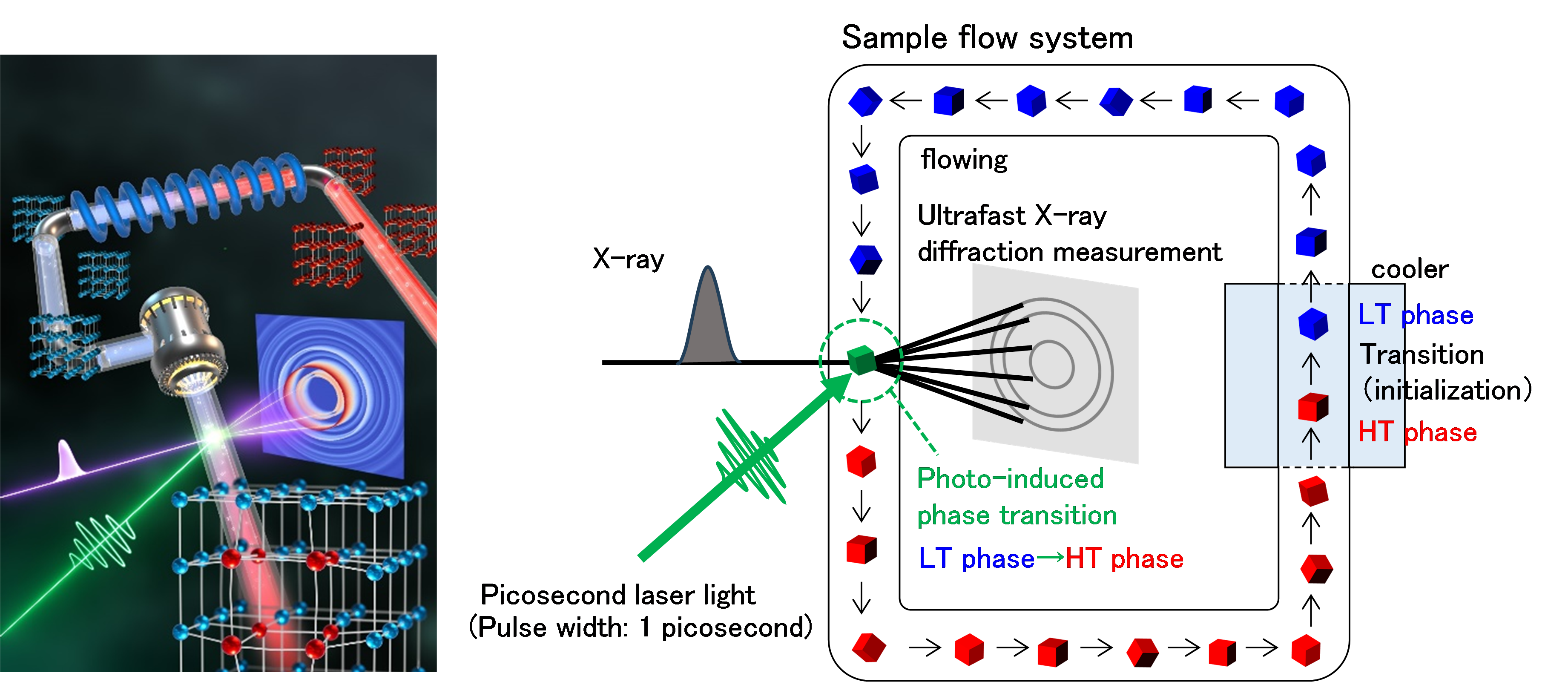DATE2024.01.24 #Press Releases
Ultrafast Monitoring of Crystal Changes in Photonic Memory Materials Now Possible!
-Development of sample flow ultrafast time-resolved X-ray diffraction method-
Shin-ichi Ohkoshi
Professor, Graduate School of Science, The University of Tokyo
Director, DYNACOM, CNRS International Research Laboratory, France
Professor, Cryogenic Research Center, The University of Tokyo
Hiroko Tokoro
Professor, Faculty of Pure and Applied Sciences at University of Tsukuba
DYNACOM, CNRS
Eric Collet
Professor, University of Rennes
Deputy Director of DYNACOM, CNRS
Photo-induced phase transition of optical recording materials at room temperature is an irreversible phenomenon. It is caused by a single shot of laser light irradiation, and thus, it is difficult to observe changes in the phase transition over time because integrated measurements cannot be performed.
The photo-induced phase transition of optical recording materials at room temperature is an irreversible phenomenon that cannot be measured cumulatively due to being triggered by a one-shot laser irradiation, making it challenging to observe the temporal changes of the phase transition. In a recent study, a collaborative research team led by Professor Shin-ichi Ohkoshi from the Graduate School of Science at the University of Tokyo (also Director of the CNRS International Research Laboratory DYNACOM (*1)), Professor Hiroko Tokoro from the Faculty of Pure and Applied Sciences at University of Tsukuba (also affiliated with CNRS DYNACOM), and Professor Eric Collet from the University of Rennes, France (Deputy Director of CNRS DYNACOM), has developed a new measurement method called sample flow ultrafast time-resolved X-ray diffraction. This method allows the monitoring of crystal structural changes induced by light irradiation using ultrafast X-ray diffraction. After observing X-ray diffraction, the phase-transitioned material is reset by flowing and cooling a liquid in which the material is dispersed. This process allows for subsequent light irradiation. Utilizing this technique at the beamline of the European Synchrotron Radiation Facility (ESRF), the team successfully observed the crystal structural changes during the photo-induced phase transition in a rubidium-manganese-cobalt-iron Prussian blue compound (Rb0.94(Mn0.94Co0.06)[Fe(CN)6]0.98) (*2). The development of this sample flow ultrafast time-resolved X-ray diffraction technique is expected to advance research on the temporal dynamics of irreversible phenomena such as photo-writing and photo-erasing.

(*1) DYNACOM (Dynamical Control of Materials), CNRS International Research Laboratory, France: Launched in 2022 by the French Centre National de la Recherche Scientifique (CNRS), the University of Tokyo, and the University of Rennes, is an international institute for the study of the fast time dynamics of optical phase transitions. Research is being conducted in collaboration with the European Synchrotron Radiation Facility and the Swiss X-ray Free Electron Laser Facility.
(*2) Rubidium-manganese-cobalt-iron Prussian blue compound (Rb0.94(Mn0.94 Co0.06)[Fe(CN) ]6)0.98: Rubidium-manganese-iron Prussian blue (RbMn[Fe(CN)6]), the parent material of the present material, is a compound first reported by Ohkoshi et al. in 2002 [S. Ohkoshi, et al. J. Phys. Chem. B, 106, 2423 (2002)]. The substance in this study is a partial substitution of manganese (Mn) with cobalt (Co).
For more details, please read the article:
Marius Hervé, Gaël Privault, Elzbieta Trzop, Shintaro Akagi, Yves Watier, Serhane Zerdane, Ievgeniia Chaban, Ricardo G. Torres Ramírez, Celine Mariette, Alix Volte, Marco Cammarata, Matteo Levantino, Hiroko Tokoro*, Shin-ichi Ohkoshi*, Eric Collet*. 2024. Ultrafast and persistent photoinduced phase transition at room temperature monitored by streaming powder diffraction. Nature Communications. DOI:10.1038/s41467-023-44440-3


